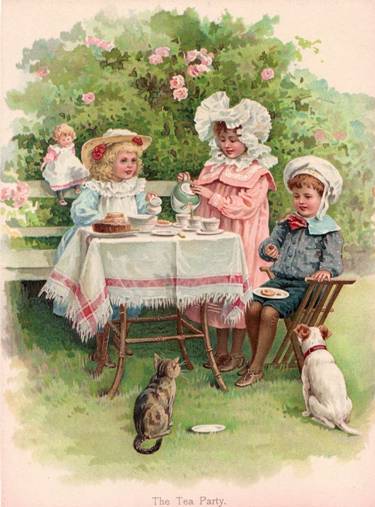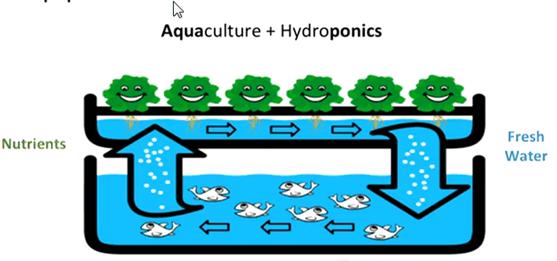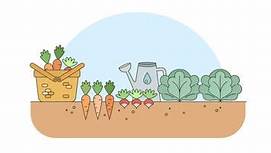
Salty Sam’s Fun Blog for Children
Number 509
Gardens of the Future
Hello Everyone

Around this time of year, Auntie Alice is putting her garden ‘to bed’, as she puts it.
When you are a busy gardener, the winter is a time of rest for you as well as the plants.
When the spring comes it is all the more welcome at the end of a cold, grey winter.
There are flower pots to scrub clean and dead stalks to be put on the compost heap.
And then of course, over the winter, there is next year to plan for.
You always need to be thinking of the future when you are a gardener.
When you think about it, although people have been tending gardens for many hundreds of years, gardening has not really changed much in all that time.
The Romans set out formal gardens around their villas and mediaeval people loved growing rose gardens and herb gardens. The Tudors loved knot gardens and the Georgians loved formal symmetrical gardens
The Victorians loved stroll gardens that they could walk in and walled kitchen gardens to grow fruit and vegetables in.
But in all this time, tools like spades and hoes and watering cans have not changed much.
Technology has been introduced to gardens, but on the whole they are as natural as they have always been.
Technology has given gardeners automatic irrigation systems which are useful for people who have busy lives and can get home from work to see that a watering job has been done for them. There are also television screens for the garden and solar lights and solar water fountains which charge themselves up in the daylight and don’t need wiring in.
There are fabrics that can be left out in all weathers, some even with patterns that glow in the dark, so that you can have really comfortable garden furniture.
Sculptures can be made from modern materials too as well as the traditional stone and metal.
Disease-free vegetables and flowers that have been bred especially have made it easier to guarantee good crops and a healthy garden.
So what about gardens of the future?
Well, one of the aspects of modern life is that a huge percentage of the population now lives in cities in a lot of countries and most of them are breathing in toxic air.
City life is noisy and stressful and can be hotter in a warm summer than rural places.
Some cities have been built with green spaces for people to get away from the hustle and bustle, and millions of street trees help to purify the air and soak up heat before it hits the pavement.
Roof gardens with solar panels to generate electricity are not a new idea, but lots of modern architects are designing block of flats now with extended balconies that can be mini gardens. Even trees can be grown in them and water features with running water which can help to mask city noise.
Sheltered gardens in cities can sometimes grow warmth-loving plants like lemon trees and fig trees and banana trees – and these can be left out all year.
Some city walls are covered with plants to created vertical gardens when space is in such short supply. Moss is often incorporated into these displays of plants and, surprisingly, if the right types are chosen, only a few square metres of moss can absorb more air pollution than many, many tree canopies.
Trees can be grown inside buildings too if there is enough light for them. lt is just like putting them inside a large green house. A watering system can be built into the beds they are planted into and then it doesn’t matter that the trees aren’t rained on.
People are talking about having tall buildings in cities that will act like greenhouses for food production. They won’t be office blocks or apartment blocks; they will be a sort of vertical farms. Growing food like salad crops and fruit in the centre of cities will mean the food can be very fresh when delivered to the nearby shops – with very little transporting needed to get it there.
Some produce is already grown in cities – very often in cellars with artificial lighting. Cellars without windows are places people don’t tend to want to inhabit.
Mushrooms specially do well in cellars but lots of different crops, like tomatoes, lettuces and herbs, can be grown as well.
Aquaponics is a modern idea for growing crops in quite small places.
Aquaponics is the combination of hydroponics which means growing plants without soil and aquaculture which means keeping fish, or maybe other types of aquatic creatures. The fish can be ornamental goldfish.
The fish waste is broken down and purified in the grow beds and the plants are fed by the nutrient rich water that runs through them. The system is totally organic, does not require vast amounts of water and plants can even be grown vertically to save space.
The growth rates of the plants are fast, they can be grown closely together, pests don’t get inside the growing rooms and harvesting can take place all year round.
Gardeners are thinking more and more about how to be eco-friendly in their own gardens too.
They are using less peat and fewer rocks taken from natural landscapes.
They are using more recycled materials in their gardens like mosaics made from recycled broken crockery or hardcore from ground up old bathroom suites and, of course, they are reducing the use of plastics.
Using household waste like tyres, bottles, boxes and cans can save money too.
They are using solar panels for lighting and heating swimming pools.
They are thinking about possible flooding and hosepipe bans when extreme weather hits. They may even plant drought-tolerant plants.
Brick paths laid on a sand base can let surface water drain away. Rainfall pockets covered by grills can let water pool and then soak away into the ground over time.
Gardeners who use water mindfully and collect rain water in butts can reduce their water bills and allow water boards to take less water from the environment for domestic use.
Gardeners are using fewer poisons in their gardens than they used to. They are using other ways to control pests. They set up bug hotels in their gardens.
lf you have a Drosera on your window sill or in your greenhouse and you will not have problems with fruit flies.
Many people are looking to keep bees and if they haven’t got room for hives they can grow bee-friendly flowers and set up bee watering stations. Bee hives and/or gardens can be put on flat roof tops.
Any plants that give something to wildlife can act as wildlife corridors.
lf you want to plant trees in your garden to help stop global warming it might be useful to know that broadleaf trees are a better choice than conifers.
Above the invisible line that runs around the top of the world called the taiga only conifers will grow.
But because of their dark colour, it has been observed that they absorb more heat and reflect less of it back into space.
Therefore, for the purposes of helping reduce global warming, broadleaf trees are a better choice of sapling to plant where possible.
Broadleaf trees are also more able to spread their seeds further afield to plant more trees. This is because broadleaf tree seeds tend to be lighter than conifer trees seeds and can be carried on the wind.
ln woodlands, broadleaf trees can spread into treeless areas more easily than conifers like spruce and pine.
The word for things on Earth reflecting solar radiation back into space is albedo (pronounced albeedo). Freshly fallen snow is good at reflecting solar radiation so has a relatively high albedo.
You will notice how dark clothing and cars absorb more of the sun’s heat than light-coloured ones.
There are many small trees for small gardens. There are miniature Acers, birches, lilacs, flowering cherry trees, fruit trees and different types of willows.
The gardens of the future will used space well and care for the environment but continue to give as much pleasure to humans as they always have.
lf you like my blog, please support it by telling all your friends and followers about it.
Thank you!
And see you again next Fun Friday!
Love and kisses
Salty Sam

www.christina-sinclair.com


Bill and Bob’s Joke of the Week![]()
![]()
Bill: Why do gnomes laugh when they play football?
Bob: l don’t know, tell me.
Bill: Because the grass tickles their armpits!

Salty Sam © Christina Sinclair 2015
Unauthorized use and/or duplication of material from this blog without express and written permission from this blog’s author and owner is strictly prohibited.
Links may be used to www.christina-sinclair.com

Picture Gallery
 Acanthus flowers were very popular in Roman gardens
Acanthus flowers were very popular in Roman gardens
Also called bear’s breeches
 Tudor knot garden
Tudor knot garden
 Victorian tea party in the garden
Victorian tea party in the garden
 Old wheelbarrow
Old wheelbarrow

 Aquaponics
Aquaponics
 ODD Architects
ODD Architects
 ODD Architects
ODD Architects

 Drosera (Sundew plant)
Drosera (Sundew plant)
 Drosera (Sundew plant)
Drosera (Sundew plant)



 THE SALTY SAM NEWS DESK
THE SALTY SAM NEWS DESK

This week, Miss Pringle gave her class an idioms quiz.
Do you know what these phrases mean?
- To weed out
- A perennial problem
- A problem stems from
- Uprooting
- Doing the spadework
- An offshoot
- To branch into
- To dig out something
- To plough back
- To bear fruit


*********************
TO ADVERTISE ON THIS BLOG
PLEASE CONTACT:
christina.sinclair.ads@aol.co.uk
*********************

 Quick Quiz
Quick Quiz
Do you make checklists?
- They reduce very c _ _ _ _ _ x tasks to s _ _ _ _ _ r steps
- They release s _ _ _ s because you know you won’t f _ _ _ _ t anything
- They make you more e _ _ _ _ _ _ _ t
- You free up your b _ _ _ n to deal with t _ _ _ s not as a m _ _ _ _ y store
- You can see p _ _ _ _ _ s which is satisfying
- You can learn more about how you tackle p _ _ _ _ _ _ s
- They can help when you feel o _ _ _ _ _ _ _ _ d
- They can improve s _ _ _ _ y
- They can be lists of things to do, buy, pack, prepare for f _ _ _ _ e events
- They can be put onto c _ _ _ _ _ _ s to organize them into a time line

Do you have over-whelm?



lt’s the Weekend!

HOW TO MAKE A GARLAND AND FESTlVE STOCKlNGS FOR A DOLLS’ HOUSE
Emily’s mum let her put some decorations up in her bedroom and she wanted to add some more to her dolls’ house as well.
This might seem a bit early to you if you are the kind of people who only put your decorations up on Christmas Eve; but once the children see the decorations going up in the shops in Rocky Bay, they start getting excited that Christmas is coming and want to start making presents and decorations.
This garland can be used to decorate a staircase or chimney breast.
You will need to knit as many stockings as you have people living in your dolls’ house – so one each, and don’t forget their pets!

GARLAND (MAKE TWO LENGTHS)
Using 4mm knitting needles and green dk yarn cast on 15 stitches
Cast off and use the ends to make loops
Add bows of red yarn on top of the garland and sew them on with white yarn

STOCKING (MAKE ONE)
Using 4mm knitting needles and white dk yarn cast on 6 stitches
Knit 2 rows of garter stitch
Change to red dk yarn
Knit 10 rows of stocking stitch
Don’t cast off
Cut off your yarn and thread it through your stitches
Pull the end of the stocking in and use the yarn to sew up the side with wrong sides together
Use the white yarn left at the beginning of the knitting to sew up the top and make a little loop
Bend up the bottom of the knitting to make a stocking shape

Please note that the material on this blog is for personal use and for use in classrooms only.
It is a copyright infringement and, therefore, illegal under international law to sell items made with these patterns.
Use of the toys and projects is at your own risk.
©Christina Sinclair Designs 2015

Answers to the News Desk Quiz
- To weed out – to get rid of something unwanted
- A perennial problem – a problem that keeps returning
- A problem stems from – stems from means come from a certain source
- Uprooting – moving to a different place
- Doing the spadework – preparing a foundation on which to create a project
- An offshoot – a project that has come from another one
- To branch into – to create a new project as an aside from another one
- To dig out something – to find something amongst a lot of other things – like a file in an office
- To plough back – to reinvest something into a project
- To bear fruit – to reap the rewards of hard work put into a project, to get success or make money



Quick Quiz Answers
- They reduce very complex tasks to simpler steps
- They release stress because you know you won’t forget anything
- They make you more efficient
- You free up your brain to deal with tasks rather than being a memory store
- You can see progress which is satisfying
- You can learn more about how you tackle processes
- They can help when you feel overwhelmed
- They can improve safety – they are used by doctors and engineers to improve results in the work that they do
- They can be lists of things to do or buy, pack, prepare for future events
- They can be put onto calendars to organize them into a time line

Are you stressed out?

TODDLER CHECK LlST



great submit, very informative. I’m wondering why the opposite experts of
this sector don’t notice this. You must proceed your
writing. I’m sure, you have a huge readers’ base already!
Yes, l have quite a few readers now Vickey. Thank you for writing in with your kind comment.